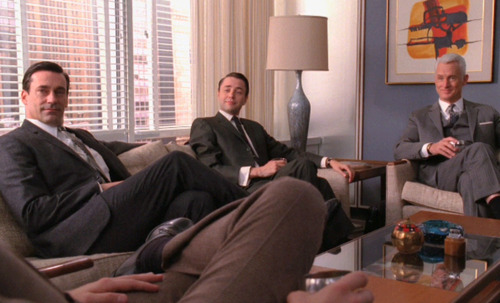 “Who Are You?” asks members of Culture on the Edge to reflect
“Who Are You?” asks members of Culture on the Edge to reflect
on one of their own many identities (whether national, gendered,
racial, familial, etc.), theorizing at the same time the self-
identification that they each chose to discuss.
Sometimes when students are in my office and I’m trying to draw their attention to the sometimes subtle ways in which we act ourselves into certain sorts of identities I’ll ask them to take a quick look at how we’re both sitting. There’s a good chance that I’m behind my desk, reclining a bit in my office chair, and seated like those guys above, and there’s an equally good chance that the student I’m talking to is not seated like this. And so drawing attention to how we’re both sitting — something that we’ve each done quite unselfconsciously, I’m sure — gives us a chance to think through identity as an empirically observable thing, as something we persuade ourselves and others that we have by repeatedly acting ourselves into it.
I’m hardly the first to think this — performativity studies abound; want a crash course?
But sitting with a student in my office, each looking at who sits how, can be a great way into this approach — especially if we see the behavior as creating the conditions for identification rather than what I take to be the more conservative approach of seeing the behavior as merely being the outward expression of some unseen inner impulse.
So it’s not that I sit like this now because I’m an adult; instead, it may be the case that I am judged by others to be an adult because I now sometimes sit like this.
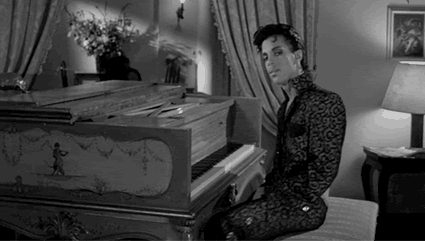 I have very clear memories of not sitting like that — if you want to see how something functions, imagine it not being the case — when I was much younger, much like the memories of not eating certain foods when I was a kid, foods I then despised but foods that, as an adult, I now relish — “I would’ve never eaten this as a kid,” I find myself saying sometimes at dinner. (But because I eat it now, I guess I’m all grown up.) And back then I knew that men — well, certain sorts of men, business men, men in three piece suits, men at meetings, sophisticated men being interviewed on TV, men who carried briefcases — sat with their legs crossed like that and that I, not yet being a man, not carrying a briefcase, would be judged an interloper, a pretender, if I tried to sit like that.
I have very clear memories of not sitting like that — if you want to see how something functions, imagine it not being the case — when I was much younger, much like the memories of not eating certain foods when I was a kid, foods I then despised but foods that, as an adult, I now relish — “I would’ve never eaten this as a kid,” I find myself saying sometimes at dinner. (But because I eat it now, I guess I’m all grown up.) And back then I knew that men — well, certain sorts of men, business men, men in three piece suits, men at meetings, sophisticated men being interviewed on TV, men who carried briefcases — sat with their legs crossed like that and that I, not yet being a man, not carrying a briefcase, would be judged an interloper, a pretender, if I tried to sit like that.
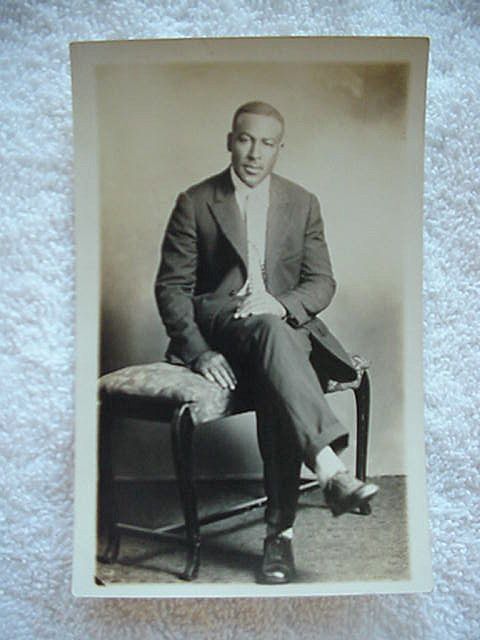 “Act your age” someone might say, with a disciplining tone, if I were to sit like that; apparently, we act ourselves into an age.
“Act your age” someone might say, with a disciplining tone, if I were to sit like that; apparently, we act ourselves into an age.
I also knew that my, shall we say, manliness might be in question if I sat like that — so not just some ill-defined, apolitical “maturity” is tied to posture and pose, but all sorts of other identifications circulate around those tightly crossed legs, such as age, class, power, and, in the case of males sitting that way, sometimes sexuality and thus their status — even their physical safety! — in a group. (I say “sometimes” because there are men whose rugged masculinity would never be in question if seated in what some see, in some instances, as a feminine pose — indicating that, like all signifiers, this one is no less slippery and complex.)
 Also, let’s be honest: it was difficult to do, since certain parts seemed to just get in the way, making it a bit of a puzzle, at least to my young self, how guys even did that.
Also, let’s be honest: it was difficult to do, since certain parts seemed to just get in the way, making it a bit of a puzzle, at least to my young self, how guys even did that.
 It took me years to feel legitimate sitting like a banker — or, better put, it took years of trying to sometimes sit like that, training to emulate the figures around me who were modeling legitimacy for me, before I felt like I could own the posture and the social implications that came with it. I recall my mother buying me a briefcase when I first got into grad school — a black one with combination locks and everything, like James Bond might casually toss on the bed of a hotel room when checking-in to some exotic locale, careful when dialing the combination lock so as not to trip the bobby trap contained inside.
It took me years to feel legitimate sitting like a banker — or, better put, it took years of trying to sometimes sit like that, training to emulate the figures around me who were modeling legitimacy for me, before I felt like I could own the posture and the social implications that came with it. I recall my mother buying me a briefcase when I first got into grad school — a black one with combination locks and everything, like James Bond might casually toss on the bed of a hotel room when checking-in to some exotic locale, careful when dialing the combination lock so as not to trip the bobby trap contained inside.
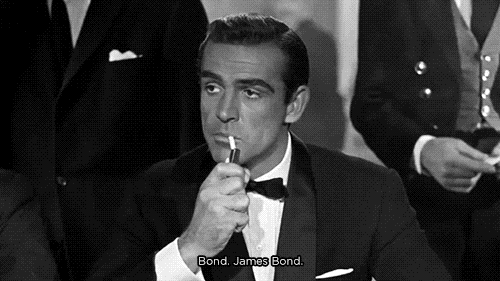 But I felt sort of silly carrying it around, like I was playing at being an adult. A backpack would do, I decided. It’s what all the cool grad students were carrying (only one strap nonchalantly slung on one shoulder though, right? Both straps made it look like you were a little too earnest, maybe the kind of person who tucked your sweater inside your pants). Sitting like a banker was much the same.
But I felt sort of silly carrying it around, like I was playing at being an adult. A backpack would do, I decided. It’s what all the cool grad students were carrying (only one strap nonchalantly slung on one shoulder though, right? Both straps made it look like you were a little too earnest, maybe the kind of person who tucked your sweater inside your pants). Sitting like a banker was much the same.
But now it comes naturally.
For, despite still feeling 18 in many ways, I’m now 52. At least as compared to my earlier self, unsure of the new selves it was slowly, inevitably becoming, a considerable amount of water has passed under the bridge, changing the bridge as it flowed; so while I’ve never quite grown into the sleek legitimacy of a black attaché case (preferring the casual, rustic look of a weathered Bree book bag that I gave my wife as a graduation present, long ago),
 I now find myself sitting, one leg tightly draped over the knee of the other, without even thinking about. While I can certainly still lean forward and throw my knees out wide while perching my elbows on them (communicating sincerity or eagerness, perhaps), maybe lean back and stretch my legs out straight with my ankles crossed, hands clasped behind my head and elbows out wide (telling the world how casual I am), or sometimes cross my legs with an ankle atop one knee, so that my legs are at about 90 degrees to each other
I now find myself sitting, one leg tightly draped over the knee of the other, without even thinking about. While I can certainly still lean forward and throw my knees out wide while perching my elbows on them (communicating sincerity or eagerness, perhaps), maybe lean back and stretch my legs out straight with my ankles crossed, hands clasped behind my head and elbows out wide (telling the world how casual I am), or sometimes cross my legs with an ankle atop one knee, so that my legs are at about 90 degrees to each other
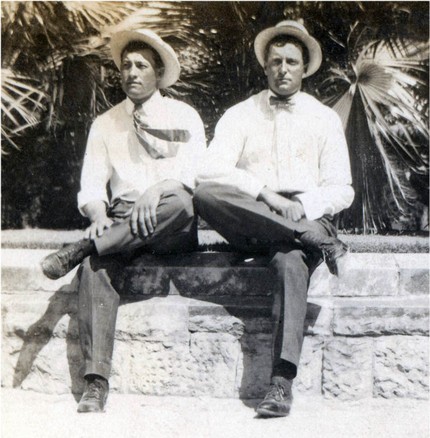 (formal, but not too formal, like wearing a tuxedo t-shirt), there’s a pretty good chance that if I look at how my body, my self, has ended up being situated in space, I’m seated in a way I never felt confident enough to chance long ago.
(formal, but not too formal, like wearing a tuxedo t-shirt), there’s a pretty good chance that if I look at how my body, my self, has ended up being situated in space, I’m seated in a way I never felt confident enough to chance long ago.
All of which is to say that, in commenting on how I sometimes sit, I’ve just told you a great deal about my self. For I’ve disclosed that I’m male (saying I “just sit” this or that way, without thinking, told you as much, since most of the women whom I know easily recall, if asked, being taught how to “sit like a lady,” usually around puberty. Case in point, consider this photo from a 1938 series on “tips for single women.”
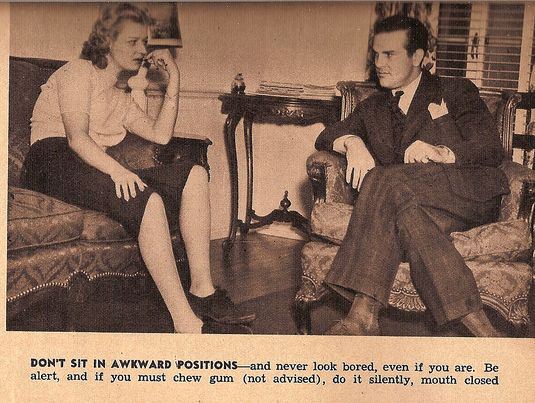 But I’ve also told you that I grew up in a homophobic culture (thus my awareness, already at an early age, of those insecure concerns for how my posture might threaten my status and perceptions of me). So too, I’ve made evident that I’m now a certain sort of professional, with a certain sort of cultural capital, who occupies a certain class position (“we” are the sort of people, after all, who call those with whom we work “colleagues,” and so we can sit like that in meetings, discussing big ideas of big consequence). And you know that I’m a certain sort of age (an age different from those students coming by my office, many of whom just seem to flop in a chair to talk).
But I’ve also told you that I grew up in a homophobic culture (thus my awareness, already at an early age, of those insecure concerns for how my posture might threaten my status and perceptions of me). So too, I’ve made evident that I’m now a certain sort of professional, with a certain sort of cultural capital, who occupies a certain class position (“we” are the sort of people, after all, who call those with whom we work “colleagues,” and so we can sit like that in meetings, discussing big ideas of big consequence). And you know that I’m a certain sort of age (an age different from those students coming by my office, many of whom just seem to flop in a chair to talk).
So who am I? I’m a middle-aged guy who sometimes sits in a certain way, and, every now and then, I try to use it, like a lot of other mundane things at his finger tips, as an e.g. to make taken-for-granted situations a little more curious, that’s who.

